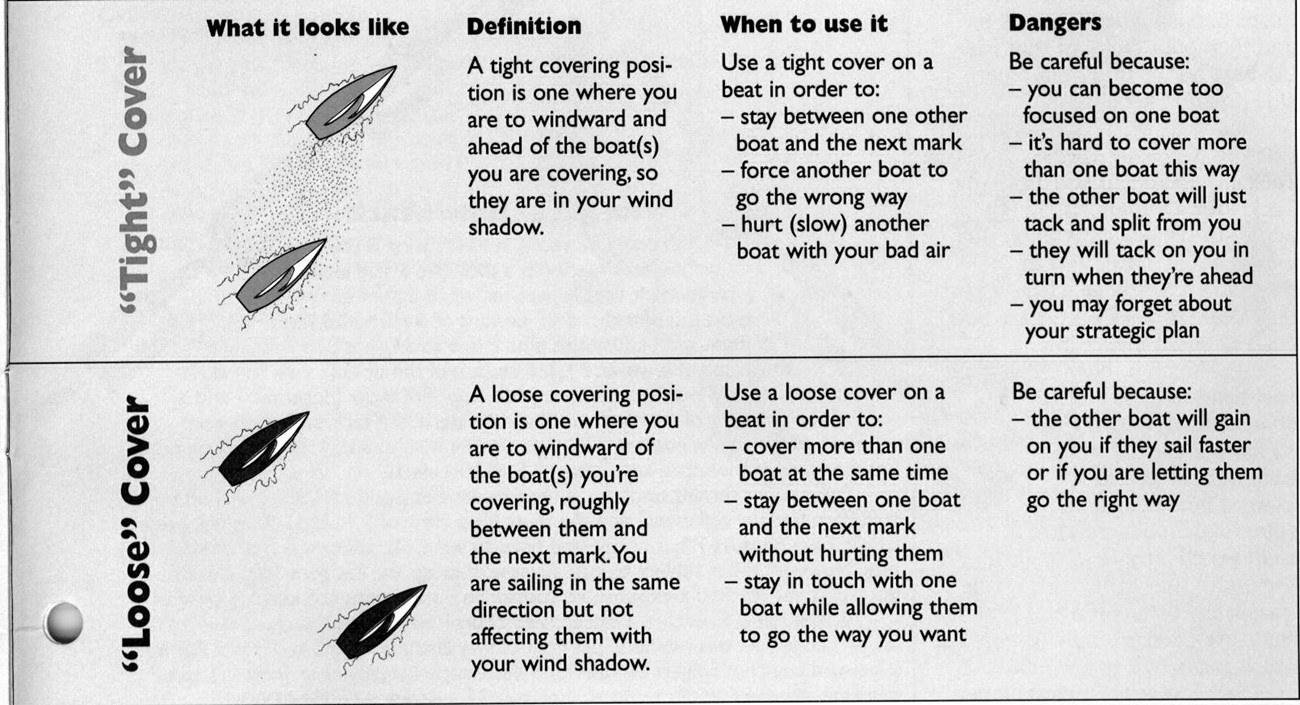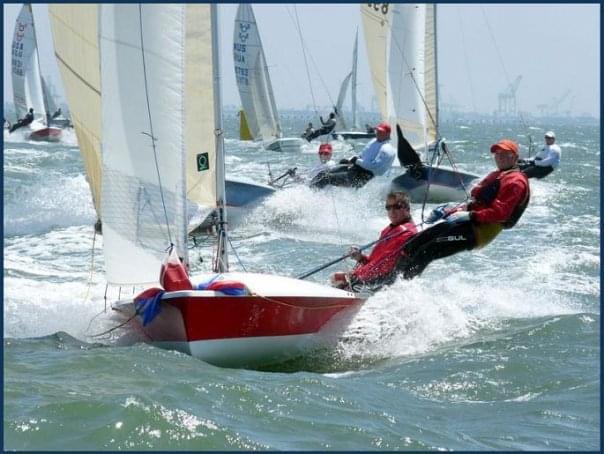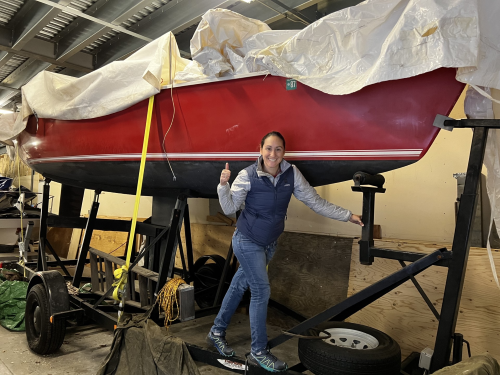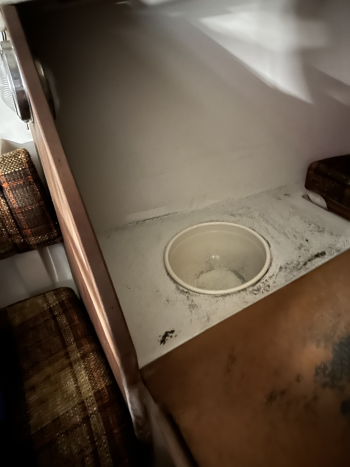The “racing concept of the month” articles are way of sharing the general racing knowledge that has been developed over the decades in the Martin 242 fleet. All are loosely based on the excellent content in this article by Michael Clements.
Don't Panic!
Many of us will remember the day we decided to get into Martin 242 sailing. Some with great fondness, others with pangs of remorse and regret. We eventually bought a nice new (to us) sailboat. We put in the hours scrubbing and splicing. We brought on new crew, and lost others along the way. We learned, we laughed, we yelled, we cried. We slowly worked our way up the pecking order, sometimes taking some giant steps backwards. And sooner than expected…one night we found ourself rounding the weather mark leading a hungry pack of 17 other boats.
You’re Finally Leading a Race! Now what!?!
Ok - first things first, in the enduring words of Douglas Adams:

image credit: nclm, CC0, via Wikimedia Commons
You got here for a reason, and while the experience may be fleeting there are ways to extend it, knowing that you’re being closely followed by other boats that will eat your lunch if you give them an opening.
Here’s a few tips:
1. Keep Going Fast
Don’t make any radical changes. The surest way to stay ahead of your competition is to continue going fast toward the next mark. If you play the windshifts correctly and keep working on your boatspeed, there's no way that anyone will catch you from behind.
There’s also a tendency for skippers to get wound up when they get into first place for the first time. Ther is a corresponding tendency for skippers to start giving their crew a hard time when things look like they may be going off the rails. Instead, it’s important for skippers to relax and let their crew do their jobs, otherwise everyone gets flustered.
2. Cover!
One of the fundamental tactics when ahead of your competition is to cover. Simply stated: stay between your competition and the next mark. Don’t give them an easy passing lane.
There are two flavours of covering to consider: loose cover and tight cover. With a tight cover you are directly affecting the wind of the boat behind, slowing them down. This will often force them to tack away to maintain speed. Loose cover is a kinder, gentler form of covering – you’re staying roughly between the boat behind and the next mark, sailing in the same direction, but without directly affecting their breeze.
You typically want to use tight cover when trying to force a boat to go a different direction, or slow them down. This works best if it is either 1 on 1 with the boat behind (late in the series if you only have one boat to beat, or if 3rd place is far behind), or if the boat behind is at or near a layline. On the layline there are limited options for tacking away (another reason to avoid laylines – the curse of the English Bay westerly strikes again!)
Outside of these specific scenarios a loose cover often works best. Loose cover is the best way to minimize the risk of giving your opponent a passing lane by simply staying close to them and sailing in the same conditions. Avoid tacking on someone’s breeze just because you can – make sure there’s a good tactical reason for it first! This also helps avoid reputational damage.
The general idea is to use tight and loose cover together to “herd” the pack of boats behind you in the same general part of the race course. Try to avoid a big split in the fleet behind you to minimize risk that someone picks up a lucky puff or shift.
More info on covering:
Covering Upwind (speedandsmarts.com)

Image Credit: How to Cover Upwind by David Dellenbaugh (sailingbreezes.com)
Caveat – sometimes let ‘em go? If one side of the course is obviously favoured, or the boat behind is heading into an obvious area of no wind sometimes it’s better just to switch focus and concentrate on sailing your own race. Always a bit of a risky call, but there’s never any absolutes in sailboat racing.
3. Downwind – Keep Your Air Clear
Downwind your focus should be more on keeping your speed up and your air clear instead of covering. A certain degree of loose cover is required, don’t let all of your competitors sail off to the other side of the course, but the priority is to keep out of the wind shadows of boats close behind. If your masthead fly is pointing toward another boat, for example, there's a good chance you're in bad air. Listen to your kite trimmer; they have the best feel for when wind gets soft.
4. Keep Fighting
If one or more boats manages to slip past you, don’t give up and accept your new position! You’re still in the front pack and you have just as good a chance to win the race as whoever happens to be in the lead now. Try and pass them back at the next mark rounding, or match-race them downwind and try to steal their air. Upwind tacking duels are unlikely to work as this will slow you both down greatly increasing the risk that other boats will catch up and pass. Only attempt this if there’s a really large gap to the rest of the boats behind, of if there’s a scoring reason you need to beat only the boat behind.
Now let's go win some races.
-written by Reto
I find myself doing a bit more sailboat work than usual this year. If you’re not down at the yacht club yourself tinkering away, you’ve at least started thinking about it. All this boat work reminded me of a great little resource I’ve had hidden in the depths of some old computer folders. If you’ve been wondering what the optimal set of tools is for working on your boat, I present you with…Mike Martin’s Toolbox!
Who the heck is Mike Martin and why should I care about his toolbox you ask?
Well, what a lot of Martin 242 sailors don’t realize is that we only sail in the second coolest one design boat in the world. Taking first place, of course, is the venerable International 5o5. For reference, here’s a photo of two anonymous sailors (who may or may not also be members of the M242 class) ripping in a 505:

Mike Martin is one of the undisputed legends of the 505 class. In a class replete with Olympians, world champions, and pro sailors taking time off to have some real fun; Mike has won 5 world championships, and is the only person to have won both as crew and as skipper. The 5o5 is also an impossibly rigged boat – surpassed in complexity perhaps only by a NASA shuttle – so it requires endless hours of tinkering. As a consequence, I don’t think you can really go wrong with the set of tools in this list (originally published in an old usa505.org article). I’ve taken the liberty of annotating which tools I think are required for working on your M242 and which are nice to have, and which I also carry permanently on board. Also added a few extras not on the original list but useful nonetheless. Enjoy!
Carolyn Costa has purchased hull #99, Red Alert, from Betsy Wareham and renamed it Gretzky. After sailing with Denise George on All In (#307) for several seasons in Marina Del Rey and with Ken Machtley on Treachery (#267) on Orcas Island, she's excited to be purchasing her first boat. Last registered in California in 1987, the boat is in vintage condition, including the sink! West Sound Marina (and Ken) will be completing the safety updates and various other projects. Carolyn is purchasing all new standing and running rigging through MG Marine. The boat comes with a great road trailer but for now will live on Orcas. The current aim is to have Gretzky in the water for summer regattas.

The Kitchen Sink!

Page 1 of 53


